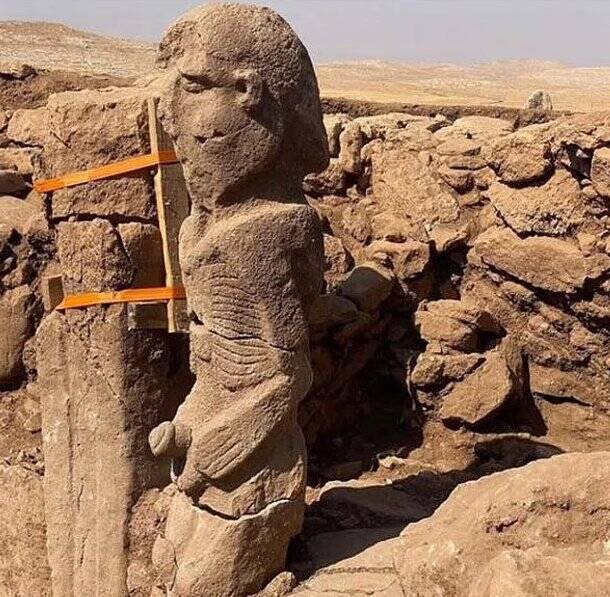The statue of the man holding his phallus at the ancient Karahan Tepe site may have been a "progenitor of a social group" and may be around 11,000 years old.

Ministry of Culture and TourismThe statue is 7.5 feet tall and was found near a smaller sculpture of a vulture.
Archaeologists working at the ancient Karahan Tepe site in Turkey have made a spectacular find during their recent excavations: an enormous statue of a man who appears to be holding his phallus.
The statue, 7.5 feet tall, was found “fixed to the ground in a bench,” according to a statement from Turkey’s Ministry of Culture and Tourism. The statement further adds that the statue of the man holding his phallus is one of “the most impressive examples of prehistoric art” and that it has “a realistic facial expression” and emphasized “ribs, spine and shoulder bones.”
Archaeologists also found the statue of a small vulture nearby. They aren’t yet sure how old either of these ancient carvings are — though Karahan Tepe is thought to be 11,000 years old — or what the phallic symbolism means.

Ministry of Culture and TourismA side view of the phallic statue found at Karahan Tepe.
“Any interpretation of the statue is conjectural at this point,” Ted Banning, an anthropology professor at the University of Toronto who is not involved in the Karahan Tepe excavations told Live Science. Because the statue may represent a dead person, Banning added that it could be a depiction of “an important ancestor associated with the building in which it was found.”
“The fact that the figure is clutching its penis is also consistent with this interpretation by potentially symbolizing that this person was the progenitor of a social group, such as a lineage or clan, associated with the building.”
In addition to the discovery of the man holding his phallus, archaeologists also announced the discovery of a life-size wild boar statue that they unearthed at Göbekli Tepe, another ancient site 22 miles away that is thought to be home to the oldest temple in the world.
One of the most exciting things about the boar statue, according to the German Archaeological Institute, is that archaeologists can still detect traces of pigment on the stone, suggesting that it was once painted.

DAI-IST/Moritz KinzelArchaeologists found pigment on the wild boar statue, which suggests it was once painted and gives an idea of what it would have looked like to ancient people.
“Remarkably, the residues of red, black and white pigments still adhered to the statue’s surface,” the statement explained. “The tongue of the boar was coloured red, with black and white pigment found elsewhere on its body. Whereas experts have long presumed that pigments played a role in the decoration of statues and T-pillars at Göbekli Tepe, there is now unequivocal archaeological evidence for this assumption.”
Both Karahan Tepe and Göbekli Tepe have challenged archaeologists’ understanding of ancient hunter-gatherer societies in recent years. As Live Science explains, experts once thought societies living in southwest Asia 11,000 years ago were simple and small in scale. But sites like Karahan Tepe and Göbekli Tepe, with their elaborate architecture and sculptures, suggest that ancient societies were complicated and organized.
Significantly, the existence of Göbekli Tepe suggests that religion may have come before agriculture and not the other way around, as many historians have long believed. Live Science reports that the ancient site was likely used by ancient people for funerary rituals.
“Göbekli changes everything,” Ian Hodder, an anthropologist at Stanford University, said of the ancient site, which was discovered in the 1960s. “It’s elaborate, it’s complex, and it is pre-agricultural. That fact alone makes the site one of the most important archaeological finds in a very long time.”
After reading about the statue of the man clutching his phallus discovered at Karahan Tepe in Turkey, see how a potato farmer in Kyrgyzstan stumbled upon a massive 6th-century warrior statue while he was plowing his field. Or, discover how archaeologists in Turkey uncovered a 2,000-year-old Roman sewer system in the ancient city of Tripolis.





